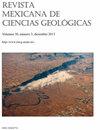Lahares secundarios en el volcán Popocatépetl: El lahar Nexpayantla del 4 de febrero, 2010
IF 0.5
4区 地球科学
Q4 GEOSCIENCES, MULTIDISCIPLINARY
Revista Mexicana De Ciencias Geologicas
Pub Date : 2020-07-28
DOI:10.22201/cgeo.20072902e.2020.2.1565
引用次数: 3
Abstract
Secondary lahars represent one of the major threats at active or quiescent volcanoes. Therefore, it is important to stablish their frequency, distribution, and triggering mechanism to define hazard-scenarios. In this work, an analysis of a lahar, that occurred on February 4th, 2010 in the Nexpayantla ravine, on northwestern sector of Popocatépetl volcano is presented. A geomorphological and textural analysis coupled with rain data and satellite imagery were used to determine its origin and to delineate inundation areas. This lahar was triggered by a 100 mm/day precipitation and initiated as a stream flow, that transformed into a debris flow, and ended as a stream flow. The transformation from streamflow to debris flow was due to sediment entrainment by laminar erosion and mass wasting processes. In contrast, its subsequent dilution was favored by changes in channel geometry, the high wood content, and the lack of fine sediment. Modelling of this lahar by numerical simulations allowed to calculate a flow depth of up to 1.7 m. Satellite imagery revealed that the deposit observed in the field represents only 68 % of the actual inundation area. Precipitation data indicates a 27-years return period for rains similar in magnitude to the one that triggered this lahar. Further detailed studies of secondary lahars will allow to better constrain hazard-scenarios at Popocatepetl volcano.2010年2月4日popocatepetl火山的次级火山泥流:Nexpayantla火山泥流
次生火山泥流是活火山或静止火山的主要威胁之一。因此,建立它们的频率、分布和触发机制来定义危险情景是很重要的。本文对2010年2月4日发生在popocatacemopetel火山西北段Nexpayantla峡谷的一次火山泥流进行了分析。地貌和纹理分析结合降雨数据和卫星图像来确定其起源并划定淹没区域。这种火山泥流是由每天100毫米的降水引发的,开始时是溪流,然后转变为泥石流,最后以溪流结束。径流向泥石流的转变主要是由于层流侵蚀和物质消耗过程的携沙作用。相比之下,河道几何形状的变化、高木材含量和缺乏细沉积物有利于其随后的稀释。通过数值模拟对泥流进行建模,可以计算出水流深度可达1.7米。卫星图像显示,现场观测到的沉积物仅占实际淹没面积的68%。降水数据显示,与引发此次火山泥流的降雨强度相似的降雨周期为27年。对次级火山泥流的进一步详细研究将有助于更好地限制波波卡特佩特尔火山的危险情景。
本文章由计算机程序翻译,如有差异,请以英文原文为准。
求助全文
约1分钟内获得全文
求助全文
来源期刊

Revista Mexicana De Ciencias Geologicas
地学-地球科学综合
CiteScore
1.00
自引率
12.50%
发文量
0
审稿时长
6-12 weeks
期刊介绍:
Revista Mexicana de Ciencias Geológicas (RMCG) publishes original research papers on geological processes of broad interest, and particularly those dealing with regions of Latin America. The RMCG also publishes review papers on topics of current interest, and on the geology and tectonics of geological provinces of Latin America. Besides, it offers the opportunity for host editors to publish special thematic issues.
 求助内容:
求助内容: 应助结果提醒方式:
应助结果提醒方式:


